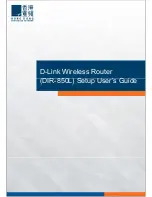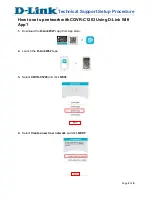
Advanced Configuration
6-9
6
MAC Address Format
– MAC addresses can be specified in one of four formats,
using no delimeter, with a single dash delimeter, with multiple dash delimeters, and
with multiple colon delimeters.
VLAN ID Format
– A VLAN ID (a number between 1 and 4094) can be assigned to
each client after successful authentication using IEEE 802.1X and a central RADIUS
server. The user VLAN IDs must be configured on the RADIUS server for each user
authorized to access the network. VLAN IDs can be entered as hexadecimal
numbers or as ASCII strings.
Primary Radius Server Setup
– Configure the following settings to use RADIUS
authentication on the access point.
• Radius Status: Enabling Radius Status allows the settings of RADIUS
authentication. (Default: Enable)
• IP Address: Specifies the IP address or host name of the RADIUS server.
• Port: The UDP port number used by the RADIUS server for authentication
messages. (Range: 1024-65535; Default: 1812)
• Key: A shared text string used to encrypt messages between the access point and
the RADIUS server. Be sure that the same text string is specified on the RADIUS
server. Do not use blank spaces in the string. (Maximum length: 255 characters)
• Timeout: Number of seconds the access point waits for a reply from the RADIUS
server before resending a request. (Range: 1-60 seconds; Default: 5)
• Retransmit attempts: The number of times the access point tries to resend a
request to the RADIUS server before authentication fails. (Range: 1-30; Default: 3)
• Accounting Port: The RADIUS Accounting server UDP port used for accounting
messages. (Range: 0 or 1024-65535; Default: 0, disabled)
• Interim Update Timeout: The interval between transmitting accounting updates to
the RADIUS server. (Range: 60-86400; Default: 3600 seconds)
Note:
For the Timeout and Retransmit attempts fields, accept the default values unless
you experience problems connecting to the RADIUS server over the network.
Secondary Radius Server Setup
– Configure a secondary RADIUS server to provide
a backup in case the primary server fails. The access point uses the secondary
server if the primary server fails or becomes inaccessible. Once the access point
switches over to the secondary server, it periodically attempts to establish
communication again with primary server. If communication with the primary server
is re-established, the secondary server reverts to a backup role.
Содержание AWAP02O-86
Страница 1: ...Enterprise Outdoor 802 11 a b g Access Point USER MANUAL...
Страница 2: ...User Guide 2 4 GHz 5 GHz Wireless Outdoor Access Point IEEE 802 11g and 802 11a Dual band Access Point...
Страница 13: ...Chapter 2 3 Hardware Installation...
Страница 22: ...Initial Configuration 5 4 5 The home page displays the Main Menu...
Страница 29: ...System Configuration 6 8 6...
















































